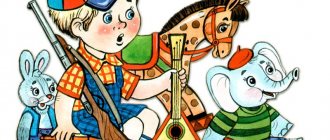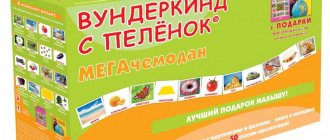The meaning of a fairy tale in a child's life. (Consultation for educators)
The meaning of a fairy tale in a child's life.
(Consultation for educators)
Teachers prepared:
;
.
A fairy tale for a child is not just fiction, fantasy, it is a special reality of the world of feelings. A fairy tale expands the boundaries of ordinary life for a child. Listening to fairy tales, children deeply sympathize with the characters, they have an internal impulse to assist, to help, to protect.
A fairy tale does its job: it helps a child navigate the world around him, enriches his mental life, makes him feel like a fearless participant in imaginary battles for justice, for goodness, for freedom, and when the need for it passes, the child himself destroys it. But until the age of seven or eight, the fairy tale for every normal child is the healthiest food - not a delicacy, but daily and very nutritious bread, and no one has the right to take away this irreplaceable food from him. A child needs a fairy tale in order to experience this most beneficial period for his mental development as fully, magnificently, and richly as possible. It is necessary to use the child’s attraction to fairy tales in order to develop, strengthen, enrich and direct their ability to creative dreams and fantasy. The future belongs to those who fantasize. It is now considered generally true that a fairy tale improves, enriches and humanizes the child’s psyche, since a child listening to a fairy tale feels like an active participant in it and always identifies himself with those of its characters who fight for justice, goodness and freedom. It is in this active sympathy of small children with the noble and courageous heroes of literary fiction that the main educational meaning of the fairy tale lies. Our task is to awaken, educate, strengthen in the receptive child’s soul this precious ability to empathize, sympathize, and rejoice, without which a person is not a person.
In order to make the most effective use of a fairy tale for the purpose of educating the moral qualities of children, it is necessary to know the features of a fairy tale as a genre. Let's look at the most typical ones.
Fairy tales
A fairy tale is distinguished from fairy tales about animals, as well as from other varieties of the fairy tale genre, by its fiction and the special forms of oral narration associated with it. Not a single fairy tale is complete without a miraculous action, without the intervention of a miracle in a person’s life. Wonderful fiction underlies the magical fairy-tale plot.
This is the most popular and most loved genre by children. Everything that happens in a fairy tale is fantastic and significant in its purpose: its hero, finding himself in one or another dangerous situation, saves friends, destroys enemies - fights for life and death. The danger seems especially strong and terrible because his main opponents are not ordinary people, but representatives of supernatural dark forces: the Serpent Gorynych, Baba Yaga, Koschey the Immortal, etc. By winning victories over these evil spirits, the hero, as it were, confirms his high human principle, closeness to the bright forces of nature. In the struggle, he becomes even stronger and wiser, makes new friends and gains every right to happiness - to the great satisfaction of his little listeners. In the plot of a fairy tale, the main episode is the beginning of the hero’s journey for the sake of one or another important task. On his long journey, he encounters treacherous opponents and magical helpers. He has very effective means at his disposal: a flying carpet, a wonderful ball or mirror, or even a talking animal or bird, a swift horse or a wolf. All of them, with some conditions or without them at all, in the blink of an eye fulfill the requests and orders of the hero. They do not have the slightest doubt about his moral right to give orders, since the task assigned to him is very important and since the hero himself is impeccable. The fairy-tale world awakens and develops the child’s imagination. The kid follows with warm sympathy everything that is said in the fairy tale. In fairy tales there are no irreparable misfortunes in life, but at the same time they do not hide the fact that the real world knows severe human suffering, but everything ends happily thanks to a miracle. The imaginary miraculous victory of good over evil always activates the child’s feelings. The need for justice, the desire to overcome life's adversities forever become part of his worldview. This is extremely important for developing a person’s vitality and the qualities of a fighter for justice. A fairy tale with its consistent composition teaches a child to think logically: the events in it unfold in strict sequence. The tale captures the dynamics of the plot. The closer the end is, the sharper and more intense the relationships between the characters become. Very often, having brought the hero to the moment of almost complete achievement of the goal, the fairy tale allows for a sharp turn of events to the starting position - and again he begins the fight for the triumph of justice. This technique helps the child understand that achieving a goal requires perseverance, loyalty to duty, and the desire to win at any cost.
Fairy tales are characterized by such a compositional feature: a threefold repetition of an episode with a subsequent intensification of the effect.
Russian folk tales
In Russian folk tales, good invariably defeats evil, but the path to this victory is long, and the hero goes through difficult trials. This is how a wise folk storyteller strengthens the spiritual strength of a growing person. Listening to fairy tales, the child is convinced that courage, perseverance and devotion can overcome any evil, no matter how terrible it may seem. It is through these examples that such important human qualities as optimism, self-confidence, and perseverance in achieving a goal are brought up.
In addition, fairy tales develop the imagination of a little person and teach him to fantasize. But children’s fantasies are a necessary condition for the full development of a child’s personality, the key to his mental well-being. In preschool age, fantasy acts as a means of assimilating life experience. In pedagogical practice, there are examples of how a child, due to improper upbringing, deprived of the opportunity to fantasize, grows up and begins to doubt the existence of very real, but unusual things. A fairy tale not only educates and teaches worldly wisdom, it also heals. Experts in child psychology say that a fairy tale helps a child cope with stress. And playing out fairy-tale situations, especially conflict ones, helps resolve controversial issues that sometimes seem insoluble to children in life. Moral and ethical problems in these works of folk art come to the fore. They mercilessly ridicule human vices: greed and stupidity, cowardice and boasting. Such fairy tales awaken the best feelings in a child, trying to protect him from callousness and selfishness. Active participation is often required from the young listener: helping the heroes of a fairy tale in difficult situations, finding ways to solve problems, that is, it is necessary to comprehend the events occurring in the fairy tale, and make independent decisions. The child must think and find a way out of the current situation, and also be able to coherently express his thoughts and prove that he is right. The final stage in the formation of coherent speech in preschoolers is the ability to tell and simultaneously show a fairy tale on an improvised stage. Conducting collective dramatizations of familiar fairy tales, children get used to the images of the heroes, trying to convey not only their words and actions, but also their characters, voices, facial expressions, and manner of speaking. This gives the opportunity to develop the creative abilities of little artists. In addition, by showing a fairy tale, children learn to regulate the strength and pitch of their voice, develop speech breathing, and intonation expressiveness of speech.
The most important task in working with children of middle preschool age is the development of correct sound pronunciation, therefore the game tasks include a large number of dynamic articulation exercises. By performing them, the child will develop accuracy and coordination of movements of the lips and tongue, switchability from one articulatory pattern to another. Psycho-gymnastics and various facial exercises serve the same purpose.
Based on the material of fairy tales, children acquire mathematical knowledge and learn quantitative and ordinal calculations. At first, young mathematicians count and compare the number of homogeneous objects (for example: “one, two, three - only three cubes”), then count dissimilar objects (for example: “a cube, a ball, a doll, a car - only four toys”).
Particular attention is paid to preparing the preschooler's hand for writing. From constructing with counting sticks, children move on to drawing in squares, with further coloring of the resulting outline drawing. When redrawing an image from counting sticks, the child must each time count the number of sticks placed in one direction or another and correlate them with the cells on a sheet of paper. This will strengthen counting skills and help the baby learn to navigate not only in space, but also on the plane of the sheet.
During visual activities, children not only draw and paint, but also name different geometric shapes, comparing them with each other in shape, color and size.
In order to learn to read, a child must have well-developed attention and memory. “Fairy-tale” activities include a variety of didactic games to improve these mental processes in preschoolers, such as “Find the extra one,” “Whose traces?”, “What are the differences?”, “Remember and repeat,” “Continue the sequence,” “Whose song?” ?”, “Be careful”, “The Magic Drum” and many others.
When auditory attention is well formed, they begin to develop phonemic hearing, that is, the ability to distinguish all speech sounds by ear. Children 4-5 years old are taught to identify the first and last sound in a word, the presence of a particular sound in a word and its position (at the beginning, at the end or in the middle of the word). When kids learn to accurately distinguish speech sounds, a new stage begins - familiarization with letters. It is important to remember that sounds are what we hear and say; and we see and write letters that are symbols of sounds. In the process of activities conducted in a playful way, preschoolers will gradually form strong connections between a visual symbol, a letter, and the corresponding sound. Preparation for learning to read also requires the need to perceive the rhythmic basis of a word: the ability to divide it into individual syllables, compare different words by the number of syllables. This educational task is served by game exercises with a “magic” drum.
Thus, introducing a preschooler to a folk tale, various didactic games based on it, and subsequent dramatization of a fairy tale plot contribute to the acquisition of new knowledge, the development of all higher mental functions and creative abilities of the little storyteller, artist, performer and student.
Tales of different peoples (Khanty tales)
The ethnopedagogy of the people, created over centuries, includes many elements that make up a unified system of educating the younger generation. There was only one task: to raise a person capable of surviving in this (often hostile) world. And all this - through participation in a complex system of religious (less often secular) rituals, games, knowledge of legends and traditions that can form a mentality (national identification), instill moral standards, give the necessary knowledge about the world around us (and an understanding of one’s place in this world) , develop intelligence, hard work, endurance, respect for Nature (nature is what surrounds the world of the human race, is around).
Fairy tales played a special role in raising children. She, and only she, had within herself such educational capabilities that even now the most powerful and modern educational technologies are not able to compare with. There is not a single people, not a single tribe lost in the vastness of our planet, where fairy tales are not told. Only a fairy tale among any non-literate people is able to explain where you came from, why, how you should live this life and where you will go later... The language of a fairy tale is universal - you can listen to it with pleasure at any age. It is not for nothing that the Pomors always took the storyteller with them to the sea to fish, and the artel took upon itself all the costs for his “accommodation”
Storytellers were especially valued among hunters in Siberia, when they needed to spend several months in a winter hut, far from people. Professional storytellers, feeding on their skills, also lived with us.
Today the need for a fairy tale seems especially great. The child is literally overwhelmed by a constantly increasing flow of information. And although the mental receptivity of children is great, it still has its limits. The child becomes overtired, becomes nervous, and it is the fairy tale that frees his consciousness from everything unimportant and unnecessary, concentrating his attention on the simple actions of the characters and thoughts about why everything happens this way and not otherwise.
For children, it does not matter who the hero of the fairy tale is: a person, an animal or a tree. Another thing is important: how he behaves, what he is like - beautiful and kind or ugly and evil. The fairy tale tries to teach the child to evaluate the main qualities of the hero and never resorts to psychological complication.
A fairy tale, more fully and vividly than any other type of folk art, reproduces the world in all its integrity and beauty. It provides rich food for children's imagination, develops imagination - this most important trait of a creator in any area of life. And the precise, expressive language of the fairy tale is so close to the mind and heart of a child that it is remembered for a lifetime. It is not without reason that interest in this type of folk art does not dry out. From century to century, from year to year, classic recordings of fairy tales and their literary adaptations are published and republished. Fairy tales are heard on the radio, broadcast on television, staged in theaters, filmed...
The Khanty are a people living in the Khanty-Mansi and Yamalo-Nenets Autonomous Okrugs, Tomsk Region within Russia. The outdated name - Ostyaks, first found in Russian documents of the 14th century, comes from Turkic languages and denotes a foreign pagan population. They live along the Ob, Irtysh and their tributaries.
The formation of the Khanty occurred from the end of the 1st millennium BC. e. based on a mixture of the northern taiga population, which was characterized by an archaic hunting and fishing way of life, and nomadic tribes who came from the southern taiga and forest-steppe regions of Western Siberia, bringing elements of southern horse-breeding culture to the north. In Russian chronicles they are mentioned together with the Mansi from the end of the 11th century under the name Ugra, and from the 14th century they are distinguished as Ostyaks.
Traditional occupations: fishing and hunting (fur hunting had commercial value), in addition, reindeer husbandry in the north and cattle breeding in the south. The main food: fish, which is processed almost completely (what is not eaten, is used to make glue, fat, utensils) and elk and deer meat. Traditional is the use of tobacco, which is chewed, snorted, and smoked. Clothing in the north was made from deer skins, in the south from prefabricated fur combined with fabrics. Fabrics were made from nettle, hemp, and fish skin was also used. Various beaded decorations are common. Both clothes and utensils are richly ornamented.
Despite the appeal in the 17th and 18th centuries. In Orthodoxy, the Khanty retained traditional beliefs (in spirits, the tripartite structure of the Universe, in the plurality of souls; veneration of animals) and rituals. One of the most striking manifestations of the bear cult is the bear festival, accompanied by the performance of special fairy tales, myths, bear songs, dances, and interludes with masked participants. Khanty folklore is rich: fairy tales, myths, heroic tales, ritual and lyrical songs. Children need to read such Khanty tales as: Ermak, Cards with Gold, Imi-Hits and Washing Urt, Imi-Hits, Mouse and Elk, Cat, Three Daughters-in-Law, Boy Ide, Mouse
Household (satirical) tales
This tale is closest to everyday life. Approval or condemnation is always given openly, the assessment is clearly expressed: what is immoral, what is worthy of ridicule, etc.
The fairy tale loves an entertaining plot, replete with comic situations. The tale is designed for continuity and unity of perception. It excludes inserted and parallel episodes. As a rule, we are talking about one conflict with a very limited number of actors.
The constant heroes of satirical fairy tales are “ordinary” poor people. However, they invariably prevail over a “difficult” person - a rich or noble person. Unlike the heroes of a fairy tale, here the poor achieve the triumph of justice without the help of miraculous helpers - only thanks to intelligence, dexterity, resourcefulness, and even fortunate circumstances.
In everyday fairy tales, sometimes animal characters appear, and perhaps the appearance of such abstract characters as Truth and Falsehood, Woe and Misfortune. The main thing here is not the selection of characters, but the satirical condemnation of human vices and shortcomings.
What do fairy tales teach preschoolers?
Fairy tales teach children not to submit to evil, not to bow their heads in the face of difficulties and danger, but to bravely fight and defeat enemies, not only with physical strength, but also with their minds.
A fairy tale introduces children to an imaginary world and makes them experience feelings with the characters that are remembered for the rest of their lives. From the very beginning of the fairy tale, the child takes the side of the positive hero. This forces children to think creatively and draw conclusions that would otherwise not be possible. Together with the main characters, the child experiences joy, fear, and sadness.
In fairy tales, there are certain rules for people to communicate with each other, statements and requests that are signs of respect for elders (for example, the expressions “bowed to the waist”, “asked for a blessing”, etc.). Such statements help the child understand how to behave among adults.
Fairy tales for preschoolers are a special educational technique.
Russian folk tale contains many linguistic devices. Artistic speech is full of epithets, comparisons and synonyms, which encourages children to create and improve their communication.
Thanks to fairy tales, a preschooler develops a sense of the line that does not need to be crossed in art. At the same time, realistic criteria for aesthetics begin to form in him.
A fairy tale is a trainer for the imagination.
And imagination, as you know, is necessary for studying subjects at school. A science such as geometry is completely impossible to understand without a developed imagination.
Thus, correctly selected fairy tales that meet the age requirements of preschoolers can have an effective educational effect on children. That is why kindergarten teachers practice reading fairy tales to children of any age. And children absorb all the necessary and useful information for themselves, which they will use for further development.
Get text
Fairy tales help to see psychological problems in time
The educational significance of fairy tales is also manifested in the fact that they are able to influence the formation of personal qualities. In childhood, the psyche is still unstable, the border between good and evil is slightly blurred. Therefore, parents need to listen to their children and their fabulous preferences.
It is possible that the characters the child loves and dislikes indicate the child’s emerging emotional problems. In this case, with the help of the same fairy tale, it is quite possible to slightly correct the development of the child’s psyche and direct it in a peaceful direction. It is very important to discuss together what you read, draw the child’s attention to some key points, and explain what is not clear.
Developmental aspect
A fairytale work develops the most important communication and intellectual skills in children:
- imaginative thinking; active speech; attention; the ability to coherently express a thought; creativity and imagination; all types of memory; the ability to correctly use facial expressions.
The characters' remarks train the articulatory apparatus and enrich the vocabulary.
The culture of speech develops, the skill of correct pronunciation of rarely used words is formed. If the fairy tale is a Russian folk tale, then the child’s speech organically includes proverbs and sayings. Thus, thanks to folklore, the child is drawn into the space of folk culture.
Numerous options for using literary material give the baby the opportunity to fully realize their potential. Expressive reading, theatrical performance, puppet or finger theater, drawing - you can play out the plot in different ways. The child feels joy, creative freedom, elation, becoming an inhabitant of a fairy-tale world.
Photo: fairy tale “The Ryaba Hen”
It is important to know:
- The role of play in raising a preschool child
Moral aspect
A fairy tale is an integral element of moral education. It is based on the perception of such basic philosophical concepts as good and evil. The language of a fairy tale is accessible to a child and makes it easy to explain to him the difference between good and bad.
The relationships between characters and the plot help to understand the reasons for an action and its consequences. The fairy tale shows a direct relationship between a person’s moral qualities and the specific life situations in which he finds himself. It teaches the most valuable quality - the ability to empathize and understand another person.
The tale forms the foundations of correct behavior and communication skills, that is, it has the most important social significance.
For the formation of a child’s moral values, the comments that parents give while reading together are very important. An equally important educational moment is the obligatory victory of good over evil. Good heroes are always hardworking, brave, beautiful, savvy, and honest. By identifying himself with them, the child adopts high moral qualities, learns to find the right solutions, and think positively.








